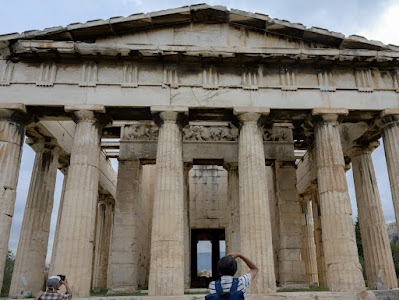Hey hey USA - 24th October - Bandelier National Monument
Despite the dust we had a good night at the Comfort Inn, and were very pleased to have been in the warm when we saw that the van was covered with frost and icicles were dripping from the trees.
We went back to the J Robert Oppenheimer house as it had not been open to the public the day before. It is quite a large house and contains a museum dedicated to Oppenheimer's life. When Oppenheimer heard the explosion at the Trinity test site he later said that the words from the Bhagavad Gita came to him "Now I am become Death, the destroyer of worlds". After the war Oppenheimer became the chairman of the US Atomic Energy Commission and used that position to lobby against nuclear proliferation and the development of the hydrogen bomb. In 1954, during the McCarthy era, Oppenheimer's security clearance was stripped from him. His politics had always been left leaning but he had never spied for the USSR as was confirmed by the Russians themselves. President Kennedy awarded him the Enrico Fermi award in 1963 but it was not until December 2022 that the revocation of his security clearance was overturned. I believe there is a film coming out about his life in the summer of this year.
It was lunchtime and we had finished all we wanted to do in Los Alamos so we set out for Bandelier National Monument. This is an area of the Frijoles Canyon, south west of Los Alamos that has been preserved for its wealth of ancient homes of the Pueblo people. It was discovered in 1880 when Jose Montoya of Cochiti Pueblo brought Adolph Bandelier to the canyon to show him his ancestral homelands.We passed some dramatic mountains on the way and as you enter the Park there is a pull off where you can look down into the canyon.
The cliffs of the canyon are formed from ash extruded when the huge volcano which created the Valles Caldera erupted. The ash reached depths of 1,000ft and as it cooled it hardened into a rock known as tuff. This is very light and soft and over time thousands of holes have been worn into the face of the cliff which the Puebloans used to form shelters.
The Puebloans had lived in Bandelier for hundreds of years. They are thought to descend from hunter gatherers who came into the area over 10,000 years ago and settled to farm and develop crafts. Archaeological surveys have shown at least 3,000 dwellings in Bandelier. At first families would have been scattered throughout the site, but by 1200AD, when the population had grown, villages were formed which would have had as many as 40 rooms. In the following 250 years fewer and larger villages were established with dwellings on the ground and also the cave dwellings or caveates. By 1500AD the land had started to become infertile and following a harsh drought the population dispersed into villages along the Rio Grande
There is a marked trail that led us around all the features of interest. Close to the entrance to the park is the remains of a great kiva. A kiva is a stone circle built partially underground used for ceremonial and public purposes.
The path meandered by a stream and the trees looked fine in their autumn colours. We soon got our first view of the cliff with the dwellings in it.
The trail takes you to the site of Tyuonyi village. Here rooms were built on the ground using tufa blocks which are easy to cut and work. The Puebloans used mud to mortar the blocks together. This village would have been occupied at the same time as the cliff dwellings. Here is a view of the village from higher up so that you can see how large it is. Then following are pictures of the stone work with the cliffs and dwellings rising beyond.
By the time we had got to the cliff dwellings the sun had gone in unfortunately and there was still small vestiges of frost on the ground. The cliff dwellings would have been accessible by ladder and there were a couple of ladders in place so that we could get a look in.
Inside the rooms were really small and we could see where the walls had been blackened by smoke. The Puebloans plastered the inside of their shelters and smoked them to make the walls less friable.
There had unfortunately been some damage to one of the more interesting caveates.
Finally we came to the area known as the Long House. Here dwellings were built on the ground but then extended back into the cliffs. Here we could see the holes for roof beams and ladders that had been carved so that the people could ascend to rooms at upper elevations of the cliff. It must have been a fantastic sight when it was being used.
In places the cliffs have been carved with petroglyphs or painted.
While we were looking at the Long House the sun came out again and the sky looked stormy. Here are some views down the length of the Long House.
As we walked back to the visitor centre their was some wonderful light on the landscape.
Here is very full description of Bandelier and it's people http://www.npshistory.com/publications/band/hrs.pdf















































Comments
Post a Comment